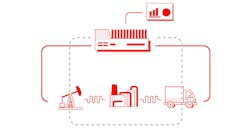How EHS Software Helps Businesses Keep Pace with Transforming Work
The speed and the pace of work is creating new challenges and opportunities for health and safety in the massive volumes of data that can be captured by EHS management systems and how it can be used to improve performance.
Technology is the driving force behind workplace transformations and will be the engine powering environmental health and safety or EHS management to ensure it keeps pace with the ever-changing and increased speed of work.
An article in the Houston Chronicle (CHRON) reports that technology’s impact on work has exponentially increased the rate of production and speed at which business occurs, adding that, “technology in the workplace has helped workers become more efficient than ever before. What used to take hours now can take minutes.”
The World Economic Forum’s 2020 Global Risks Report says 73 percent of executives predict significant industry disruption in the next three years due to technological changes, and one in five current jobs will be replace by artificial intelligence and automation.
The speed and the pace of work is also creating new challenges and opportunities for EHS in the massive volumes of data that can be captured by EHS management systems and how it can be used to improve safety performance. Intelex Safety and Health Vice-President and Global Practice Leader Scott Gaddis says technologies such as cyber-physical systems, the internet of things, cloud and cognitive computing are powering Industry 4.0 or the fourth industrial revolution. Workplaces move faster and are more complex, and EHS management systems need to keep pace.
“You’re going to need system tools, such as EHS software and technology, to help you understand the information,” he says. “I don’t think there is a replacement for the safety and health professional. However, I think there are aids that help us make clearer and better decisions – as close to near time as we can possibly make it.”
Progress and improvement moved steadily throughout almost 40 years of EHS, beginning with the Occupational Health and Safety Act (OSHA) which ignited a focused drive towards compliance and physical controls, leading to behavioral-based safety programs that gained strong traction in the 1980s. Knowledge and capability training, based on new methods of transferring information, took hold in the 1990s leading to combined and layered approaches to mitigating risk in the 2000s. But safety performance results and outcomes have peaked, according to Gaddis.
“Up until 2009, we literally had lowered workplace fatalities in the U.S. to about 5,000 a year,” Gaddis says. “But what we’ve noticed over the last decade – from 2010 on – it’s been static. We’ve not seen a lot of change. So, we’ve plateaued in some regard.”
Can technology change the EHS management landscape and move the dial further in the direction of reducing workplace injuries and fatalities? Gaddis says it can and will. EHS software and technology today are being used to digitally reconstruct safety management, connecting what have been separate pieces together, digitizing and delivering information faster and with better accuracy.
“There will come a time when manual gathering of data from the workforce will not be required,” he says. “With the right devices, hubs and platform ecosystem, monitoring will be done in real-time or near real-time. We know that technology helps you make better decisions and we’re only starting to understand this potential. Sensors and data monitoring are just the beginning of what we’ll see in the current decade ahead.”
A new safety model process, powered by technology, is emerging – EHS 4.0, a term that describes connected technologies used to leverage data collected through centralized EHS management systems. Gaddis explains he’s been working on a project at Intelex that examines safety data collected by Intelex customers who use the company’s safety management system that connects to a range of typically disparate processes. By examining this amassed data and considering the metrics tracked in those systems, “what we started to see was that our clients were using that information in a leading way,” he says.
“We started looking at our customers’ investments, what kind of applications they were using and then tried to come up with an evidence-based assessment between those that really did well and those that had opportunities to improve,” Gaddis says. “We came up with this idea called the safety engagement score to qualitatively look at indicators”
Examining nine processes and applying an algorithm to the metrics produces a safety engagement score overall and for each indicator. Gaddis says it’s basically a measure of safety process strength.”
“You could have more metrics, but you choose the ones that are important to you,” he says “This is what we look at globally with our thousands of clients. These are the key eight or nine metrics across the spectrum. The order or value of each score is really what becomes important. We assessed those that were important to most of our clients.”
Processes examined include safety audits, information distribution, safety meetings, safety investigation, training, safety recognition, action management plus hazards and observations. Analyzing these collectively assigns a dashboard value that provides an overall safety process strength score. Data can also be viewed relative to each safety process metric, scoring each individually so that you can see areas of strength and weakness. Using this information, safety professionals can create better strategies and tactics to achieve performance improvement.
Gaddis explains that data can also be parsed in a way to show safety performance scores for various operations across a large company with many locations. In a single metered view, safety process strengths can be assessed across operations and areas for improvement can be identified.
Technology today is used to construct digital EHS management systems, connecting all the pieces together to obtain information faster and with better accuracy, assuming data are entered correctly.
“Closing your system gaps and determining the level of safety process strength is really important,” he says. “I think you’ve got to determine that within your organization – how much variability do you want to allow in your processes?
“Safety management factors are interwoven,” Gaddis adds. “Work that you do to build robustness within any management system affects other parts of that system. So, when change happens within one part, it generally results in a challenge, opportunity or change in other management factors.”
Intelex’s Safety Management and EHS Software captures, tracks and reports safety program data, analyzes trends and draws insights from easy-to-use dashboards while meeting workplace compliance requirements and reducing administrative work. Try it for free.


